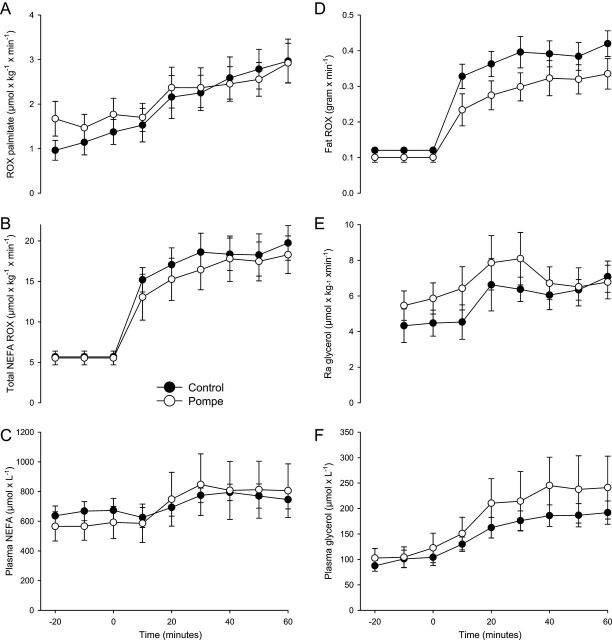Figure 4.
Fatty acid metabolism and glycerol turnover during submaximal exercise. (A) Average palmitate oxidation rate (ROX) in patients during exercise, 2.396 (s.d. 1.016) µmol/kg/min was similar to controls, 2.380 (s.d. 1.162) µmol/kg/min; mean difference 0.016 µmol/kg/min (CI: 1.287 to −1.255, P = 0.710). (B) Oxidation rates of non-esterified fatty acids (NEFA) per kilo body weight did not differ between patients 16.4 (s.d. 6.6; range: 6.2–25.7) and controls 17.9 (s.d. 5.4; range: 13.1–29.3) µmol/kg/min (P = 0.805) during exercise. (C) The concentration of plasma NEFAs increased in patients 768 µmol/L (s.d. 466; range: 263–1496) and controls 734 µmol/L (s.d. 151; range: 493–963) (P = 0.710) during exercise. (D) ROX of fat 0.298 g/min (s.d. 0.109) did not differ between patients and controls 0.380 g/min (s.d. 0.095) (CI: 0.036 to −0.202, P = 0.209). (E) The rate of appearance (Ra) of glycerol, reflecting adipose tissue lipolysis, was similar between patients 7.065 µmol/kg/min (s.d. 2.728) and controls 6.168 µmol/kg/min (s.d. 1.791), during exercise; mean difference 0.897 (95% CI: 3.584 to −1.790; P = 0.456). (F) Plasma glycerol concentrations were also similar during exercise in patients 217 µmol/L (s.d. 131; range: 417–55) and controls 172 µmol/L (s.d. 48; range: 108–260) (P = 0.456). Error bars are s.e.m.

 This work is licensed under a
This work is licensed under a 